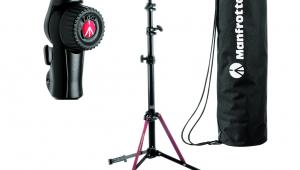I've been using tripod and its a great help for me. It made me capture photos in clear vision. Phil Melugin
Image Stabilization & Tripods; The Picture Isn’t Always Clear
“Can you use a tripod and IS at the same time?”
Almost 20 years after the dramatic success of the first autofocus 35mm SLR, the Minolta Maxxum 7000, Minolta introduced “body integral” Image Stabilization (IS) to the world in the DiMAGE A1, and the game changed. Advanced photographers recognized the value of stabilization. That was back in 2003, but it wasn’t the first attempt to quell camera jitters. Previously, IS had been performed optically. Minolta did it in the camera body by physically moving the sensor to counteract camera movement. We called it Anti-Shake, and I was a member of the team that brought it to market.
The aim of image stabilization is to improve overall sharpness by significantly reducing blur caused by camera movement at the moment of exposure. The benefits are most keenly appreciated in situations where shake does the most damage—when shooting at slow shutter speeds and when using long telephoto lenses. There are two approaches to achieving IS: build it into the camera body, or build it into the lens.
D-SLRs today from Sony, Pentax, and Olympus use a similar body-integral, sensor-offset system, while Canon, Nikon, and Panasonic build the stabilization into the lenses instead. Many Tamron and Sigma lenses are stabilized as well. Each method has its good and bad points. The most important takeaway is not which is best; rather, that they are different.
What IS Isn’t
Regardless of which method is at work, or what name it goes by, IS cannot correct for subject movement. If you are photographing a field of flowers from a distance of 12 feet and you are shooting with a stabilized system at 1⁄15 sec on a still day, odds are you’ll get a sharp image. But if the wind gusts up to 15 mph, the flowers will move and sharpness will go out the window. Don’t blame the IS system if the subject moves.
On the other hand, a good test for IS effectiveness is to use a long shutter speed to shoot a scene that contains both moving and stationary subjects. Some examples include a flowing river, a waterfall, and any busy street where people and/or cars are passing by while the buildings and streetlights hold their ground. You can easily predict the outcome.
IS On Three Legs
The tripod is the original form of IS, and has proven its effectiveness for literally hundreds of years (no doubt Aristotle used one to stabilize his pinhole camera). So this begs the question: can you use a tripod and IS at the same time? We’d like to put this question to rest, once and for all.
Sadly, we cannot in all cases, although we can say this for sure: if the IS system is built into the body, turn it off when using a tripod. Sally Smith Clemens, product manager for Olympus, told us why.
“Image Stabilization systems are designed to look for and counteract camera motion,” she said. “When the camera is mounted on a tripod, there is little or no movement for this system to react to, but the camera is still searching and trying to compensate for movement. The result can be softer images due to the activity of the IS system.” Representatives from Pentax agreed.
When using certain Nikon VR lenses and late-model Canon IS lenses in conjunction with a tripod, it might be better to leave stabilization on. Sometimes. If you are in doubt, turn it off.
Lindsay Silverman, senior product manager at Nikon, explained that with many of their VR image stabilized lenses, you have to turn VR off. The reason, he explained, is that the VR mechanism is vibrating and looking for frequencies that will result in camera shake. If you leave the VR feature on when the camera is mounted on a tripod, the result can actually look unsharp.
However, this is not always the case.
“With many of our premier lenses and the new AF-S DX 55-300mm VR,” he explained, “there is a technology that allows the lens to stay in its active VR state when mounted on a tripod. These lenses actually have algorithms that can discern the minute vibrations that tripod legs have, and can compensate for them when shooting. Lenses like the AF-S 200-400mm VR II, the AF-S DX 55-300mm VR II, the AF-S 400mm f/2.8 VR, and the AF-S 500mm f/4 VR and AF-S 600mm f/4 VR all have the tripod detection VR mode.”
Canon’s Chuck Westfall told us that by now there are at least four distinct generations of IS technology within the EF lens line, each with its own feature set and performance levels. As a result, a blanket recommendation for the entire range of IS lenses concerning tripod use doesn’t make sense anymore.
“Boiling it down to the lowest common denominator,” he explained, “the best we could say is that shutting off IS during tripod use can often help to avoid potential image blurring at slow shutter speeds. In many cases, it won’t make any difference to image quality whether the IS switch is on or off during tripod use. However, the newer the lens, the more likely it is that the IS mechanism is sophisticated enough to reduce—if not eliminate—the effects of vibration caused by mirror slap at slow shutter speeds when the lens is mounted on a sturdy tripod.”
Confused yet? If your camera has built-in IS, turn the IS off when using a tripod. This includes all point-and-shoot cameras. If you’re using a stabilized lens—including third-party lenses like Tamron and Sigma—turn IS off. A few Nikon lenses and a handful of Canon EF lenses may actually benefit from having VR or IS turned on. As with so many things, the only way to find out what works best is to try it.
You can read Jon Sienkiewicz’s blog at: www.shutterbug.com.
- Log in or register to post comments

















































